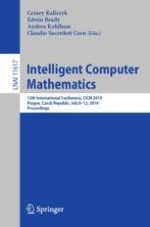2019 | OriginalPaper | Chapter
Explorations into the Use of Word Embedding in Math Search and Math Semantics
Authors : Abdou Youssef, Bruce R. Miller
Published in: Intelligent Computer Mathematics
Publisher: Springer International Publishing
Activate our intelligent search to find suitable subject content or patents.
Select sections of text to find matching patents with Artificial Intelligence. powered by
Select sections of text to find additional relevant content using AI-assisted search. powered by
